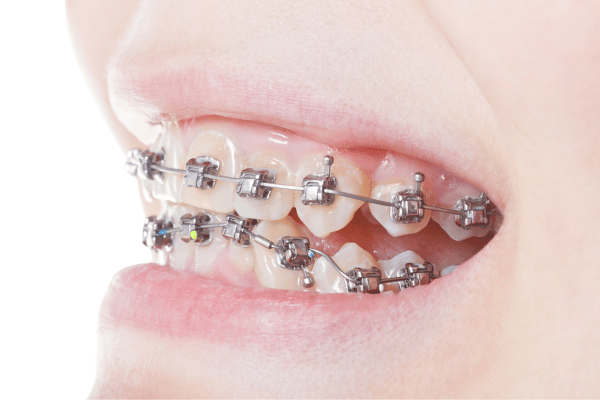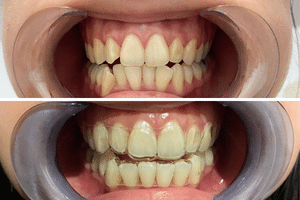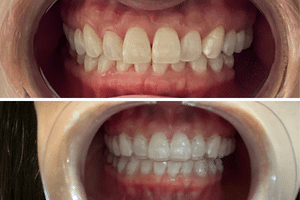
Table of contents
Hey there, fellow tooth enthusiasts!
Are you dreaming of that Hollywood smile but hesitant to commit to traditional braces? Well, you're in luck because today, we're exploring the world of at-home teeth straightening. Yes, you read that right – you can now straighten your teeth from the comfort of your home with at-home clear aligners like Aligner32. But before diving into this trend, it's essential to weigh the pros and cons and understand the decision-making process involved.
The Good
Let's start with the positives, shall we? At-home teeth straightening offers a plethora of benefits for the busy bees and introverts among us. First and foremost, it's all about convenience. Say goodbye to scheduling countless appointments and sitting in crowded waiting rooms – with at-home clear aligners, you're in the driver's seat. You can kick back on your couch, pop in your aligners, and carry on with your day without missing a beat.
Moreover, at-home teeth straightening is often more budget-friendly than traditional orthodontic treatments. With fewer overhead costs and no need for frequent in-person visits, these DIY solutions typically come with a lower price tag, making them accessible to a wider range of individuals. Plus, many at-home clear aligner companies offer flexible payment plans, so you can achieve that winning smile without breaking the bank.

Another significant advantage of at-home teeth straightening is the discreet nature of clear aligners. Unlike traditional metal braces, which can be bulky and conspicuous, clear aligners are virtually invisible when worn. This feature makes them especially appealing to individuals who are self-conscious about their appearance during treatment.
The Not-so-Good
Now, let's address the elephant in the room – or rather, the potential drawbacks of at-home teeth straightening. While the convenience and affordability are certainly enticing, there are some factors to keep in mind before taking the plunge. One of the biggest concerns is the lack of professional oversight.
Without regular check-ins with a qualified orthodontist, there's a risk of complications arising during treatment. Misaligned teeth, bite issues, and gum irritation are just a few of the potential pitfalls that can occur when clear aligners aren't properly monitored. Additionally, some cases of teeth misalignment may require more complex treatment options that only a trained professional can provide.
Another consideration is the self-discipline required for at-home teeth straightening. Unlike traditional braces, which are affixed to your teeth, clear aligners are removable. While this feature offers added flexibility and convenience, it also means that you're responsible for wearing your aligners for the recommended amount of time each day. Failure to comply with the treatment plan can result in prolonged or ineffective treatment outcomes.
Is At-Home Teeth Straightening Right for You?
Dental issue: Crowding

Dental issue: Overbite

Now that we've weighed the pros and cons, it's time to tackle the million-dollar question – is at-home teeth straightening the right choice for you? The answer ultimately depends on your individual needs, preferences, and dental health. You can fill out Aligner32’s online assessment form to better understand your dental issues. Here are a few key factors to consider when making your decision.
First and foremost, assess the complexity of your case. At-home clear aligners are best suited for mild to moderate teeth misalignment issues. If you have severe crowding or bite problems, you may require more intensive treatment that only a professional orthodontist can provide.
It's also essential to consider your overall oral health. Before beginning any orthodontic treatment, it's crucial to address any existing dental issues, such as cavities or gum disease. Untreated oral health problems can interfere with the effectiveness of at-home teeth straightening and may even exacerbate existing issues.
Lastly, take into account your lifestyle and personal preferences. If you have a hectic schedule or travel frequently, at-home clear aligners may offer greater flexibility than traditional braces. However, if you prefer the peace of mind that comes with professional oversight and personalized care, you may feel more comfortable opting for traditional orthodontic treatment.
Choosing the Right At-Home Clear Aligner Provider

Now that you're considering at-home teeth straightening, it's crucial to choose the right clear aligner provider for your needs. With numerous companies entering the market, each offering their own set of promises and services, it can be overwhelming to make a decision. Here are some factors to consider when selecting the best at-home clear aligner provider:
- Reputation and Reviews: Research the reputation of the clear aligner company you're considering. Look for reviews and testimonials from real customers to gauge their satisfaction with the product and service.
- Treatment Process and Technology: Understand the treatment process offered by the clear aligner provider. Look for companies that use advanced technology, such as 3D scanning and modeling, to create custom aligners tailored to your teeth.
- Professional Oversight: While at-home clear aligners offer convenience, it's essential to ensure there's some level of professional oversight throughout your treatment. Look for companies like Aligner32, that provide remote monitoring by qualified orthodontists or dentists.
- Transparency and Support: Choose a clear aligner provider that prioritizes transparency and provides comprehensive support throughout your treatment journey. This includes clear pricing information, detailed treatment plans, and responsive customer service.
- Flexibility and Convenience: Consider the flexibility and convenience offered by the clear aligner provider. Look for companies that offer flexible payment options, convenient shipping and delivery, and easy-to-use online platforms for tracking your progress and communicating with support staff.
By carefully evaluating these factors, you can choose the right at-home clear aligner provider that aligns with your needs and preferences. Remember, investing in your smile is a significant decision, so take the time to research and choose wisely. With the right provider and commitment to your treatment plan, you'll be on your way to achieving the smile of your dreams from the comfort of your own home.
Summary
So, there you have it – the good, the not-so-good, and the decision-making process of at-home teeth straightening. While this approach offers undeniable benefits in terms of convenience and affordability, it's important to proceed with caution and carefully weigh your options. Choose wisely and keep on shining, tooth enthusiasts!
FAQs
Q. Are at-home clear aligners as effective as traditional braces or in-office treatments?
A. At-home clear aligners can be effective for mild to moderate teeth misalignment issues. However, more complex cases may require traditional braces or in-office treatments for optimal results.
Q. How often should I wear my aligners, and for how long each day?
A. Aligners should typically be worn for 20 to 22 hours per day, only removing them for eating, drinking (except for water), brushing, and flossing. Consistent wear is crucial for achieving desired results within the estimated treatment timeline.
Q. How often do I need to change my aligners during treatment?
A. Aligners are typically changed every 1-2 weeks, depending on the treatment plan prescribed by the provider. Each set of aligners is designed to shift the teeth into the desired position over time gradually.
Q. Can I continue to participate in sports or physical activities while wearing at-home clear aligners?
A. Yes, you can continue to participate in sports or physical activities while wearing at-home clear aligners. However, it's recommended to remove the aligners during high-impact activities to prevent damage or injury.
Q. What happens if my aligners become damaged or lost?
A. If aligners become damaged or lost, it's essential to contact the clear aligner provider immediately for guidance. In some cases, replacements may be necessary, so it's important to follow the provider's instructions for continued treatment progress.


